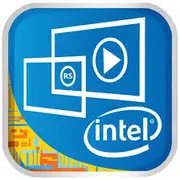Intel Core M-5Y10a

Intel Core M-5Y10a: Ultra-Mobile Processor for Compact Devices. Review of 2025
Introduction
The Intel Core M-5Y10a processor, released in 2014–2015, became part of the revolution in the ultrabook and compact device segment. Even a decade later, it remains an example of balance between energy efficiency and sufficient performance for basic tasks. Let’s explore whether this chip is still relevant in 2025 and who it might be suitable for.
1. Architecture and Process Technology: Broadwell in Detail
The Core M-5Y10a belongs to the Broadwell generation (5th generation Intel Core), manufactured using a 14nm process technology. This was the first phase of the transition from the 22nm Haswell, which allowed for reduced energy consumption without a loss in performance.
Key Specifications:
- Cores and Threads: 2 cores, 4 threads (Hyper-Threading).
- Clock Frequencies: Base — 0.8 GHz, maximum in Turbo Boost — 2 GHz.
- Graphics: Intel HD Graphics 5300 (24 EUs, frequency up to 800 MHz).
- Cache: 4 MB L3.
Architecture Features:
- Broadwell Microarchitecture: Improved IPC (instructions per clock) by 5–10% compared to Haswell.
- HD 5300 Graphics Accelerator: Supports DirectX 11.2, 4K output via DisplayPort, hardware decoding of H.265.
- Passive Cooling: With a TDP of 4.5W, the processor is often used in fanless devices.
2. TDP 4.5W: Energy Efficiency as a Priority
The 4.5W TDP (Thermal Design Power) is a key feature of the Core M-5Y10a. For comparison:
- Intel U-series processors (e.g., Core i5-5200U) have a TDP of 15W.
- Modern Intel Alder Lake-U (2023–2025) range from 9–15W.
What Does This Mean?
- Quiet Operation: The absence of a cooler reduces noise and thickness of the device.
- Thermal Stability: Even under load, the temperature rarely exceeds 60–70°C.
- Flexibility: Manufacturers can create devices with a thickness of less than 10mm.
3. Performance: Real-World Scenarios
Office Tasks:
- Document work, browser (10+ tabs), Zoom — the processor handles it, but during heavy multitasking, there may be some lags.
Multimedia:
- Viewing 4K@30fps (H.265) — no problems, thanks to the iGPU decoder.
- Video editing: Only simple projects in 1080p (for example, in Shotcut). Rendering 4K will take hours.
Gaming:
- CS:GO — 720p, low settings, 25–35 FPS.
- Minecraft — 30–40 FPS (without shaders).
- Modern games (2023–2025): Not recommended.
Turbo Boost:
Maximum frequency of 2 GHz activates for 10–20 seconds, after which it drops to 1.2–1.5 GHz due to TDP limits. This is useful for short tasks (opening applications), but ineffective for long-lasting loads.
4. Use Cases: Who Is It Suitable For?
- Students: Document work, online courses, light presentations.
- Office Workers: Email, Excel, browsing.
- Travelers: Compact 2-in-1 devices (e.g., Lenovo Yoga 3 Pro) with 7–9 hours of battery life.
- Home Media Centers: Connecting to TV via HDMI for streaming.
Not Suitable For:
- Gamers, engineers (CAD), video editors.
5. Battery Life: How TDP Affects Battery
Laptops with the Core M-5Y10a were equipped with batteries of 30–40 Wh, providing:
- 8–10 hours when working with documents (brightness 50%).
- 5–6 hours when watching videos.
Power-Saving Technologies:
- Intel SpeedStep: Dynamic frequency scaling.
- C-States: Turning off unused components.
- Panel Self Refresh: Reducing GPU load when displaying static images.
6. Comparison with Competitors
AMD of 2015:
- A6-8500P (15W, 2 cores): Higher performance, but with a TDP of 15W and less battery life.
Apple:
- MacBook 12" 2015 (Core M-5Y51): Similar to 5Y10a, but macOS optimization provided +1–2 hours of usage.
Intel of 2025:
- Intel Core Ultra 5 134U (10W, 2P+8E cores): 3–4 times higher performance with similar TDP.
Conclusion: The Core M-5Y10a has become outdated even for basic tasks compared to modern ARM chips (Apple M3, Snapdragon X Elite) and Intel's hybrid processors.
7. Pros and Cons
Strengths:
- Extremely low heat output.
- Support for 4K output and H.265.
- Compatibility with Windows 10/11 and Linux.
Weaknesses:
- Low performance in multitasking.
- Turbo mode is ineffective under prolonged loads.
- Outdated platform: DDR3L, PCIe 2.0.
8. Recommendations for Choosing a Laptop in 2025
Devices with Core M-5Y10a in 2025:
Only found on the secondary market (price: $150–250). New alternatives are laptops with Intel N-series (e.g., Acer Swift 1, $400–500).
What to Look For:
- Type of Device: Ultrabook or convertible (e.g., ASUS ZenBook Flip).
- Display: IPS matrix with a resolution of at least Full HD.
- Storage: SSD (256 GB and above) is a must.
- Ports: USB-C with charging support.
Advice: If the budget is under $600, it's better to choose a laptop with Intel Core i3-N305 (8 cores, 15W) or AMD Ryzen 3 7320U.
9. Final Conclusion
Core M-5Y10a in 2025 is:
- For whom: Users who need a cheap laptop for text work and internet use.
- Alternatives: Used MacBook Air M1 ($300–400) or new budget Chromebooks.
- Key Benefits: Quiet operation, compactness, adequate performance for basic tasks.
Final Note: If you're not ready to spend more than $200 and are looking for a device "just in case" — the Core M-5Y10a may still serve a purpose. However, for comfortable work in 2025, it's better to consider more modern solutions.
Basic
CPU Specifications
Memory Specifications
GPU Specifications
Miscellaneous
Benchmarks
Compared to Other CPU
Share in social media
Or Link To Us
<a href="https://cputronic.com/en/cpu/intel-core-m-5y10a" target="_blank">Intel Core M-5Y10a</a>